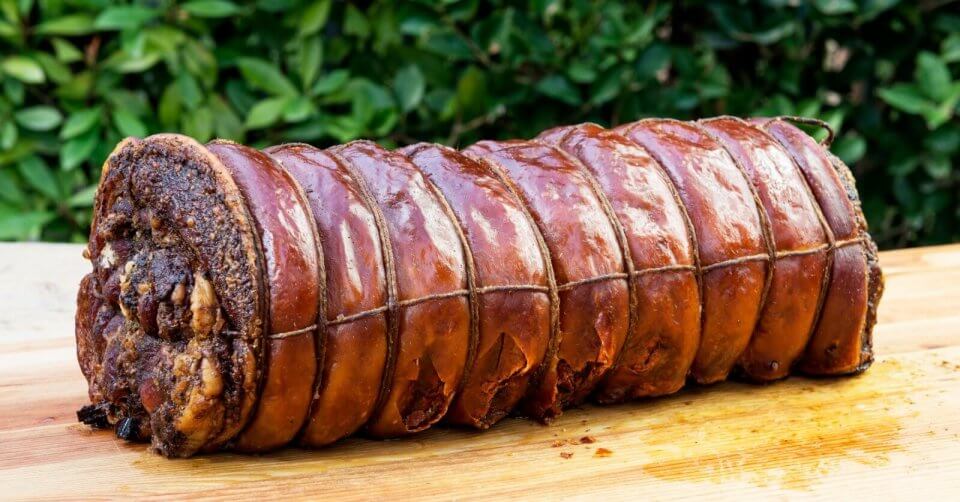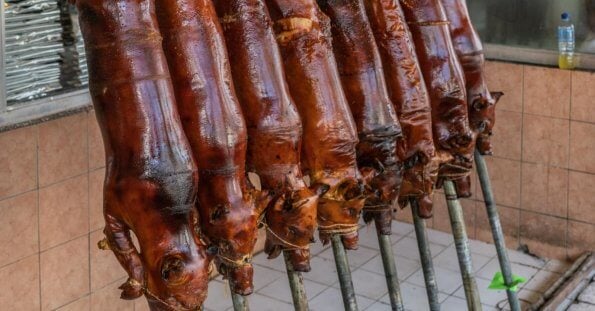What meat cuts are used for lechon roll?
Meat cuts commonly used for lechon roll include pork belly and pork roast. Pork belly is the most commonly used cut for lechon belly roll due to its layers of fat and lean meat, which results in a juicy and flavorful dish. Pork roast, on the other hand, is also used for lechon roll, especially for those who prefer a leaner meat option.
Proper preparation and seasoning of the meat are crucial to achieving the desired flavor and tenderness. The meat should be thoroughly cleaned and seasoned with a mix of spices, herbs, and salt to enhance its natural flavors.
The brining process is an essential step in preparing lechon belly roll, as it helps to infuse the meat with flavor and makes it more tender. The pork is soaked in a brine solution, typically consisting of water, salt, sugar, and aromatic spices, for several hours or overnight. This not only adds flavor but also helps to break down the muscle fibers, resulting in a more tender and succulent meat.

Contact Lechon Corner on Facebook
What is the secret of the lechon flavor?
Tanglad, also known as lemongrass, is often used in lechon for its aromatic and citrusy flavor. The use of tanglad in lechon imparts a unique and refreshing taste to the meat. It contributes to the overall flavor profile of the dish, enhancing the sensory experience for those enjoying it.
The practice of using tanglad in cooking, including lechon, is deeply rooted in Southeast Asian and Filipino culinary traditions. Lemongrass is native to tropical regions such as Southeast Asia and is widely used in various cuisines for its citrusy and herbal notes. It has become a staple ingredient in Filipino cooking, providing a distinct flavor to many dishes.
In the context of lechon, tanglad is often incorporated into the seasoning mixture that is applied to the pig before roasting. The lemongrass-infused flavor adds a bright and zesty element to the meat, complementing the richness of the pork. Additionally, some cooks may place whole stalks of lemongrass inside the pig’s cavity during the roasting process to infuse the meat with its aromatic essence.

While the use of tanglad in lechon is not exclusive to any particular region, it reflects the influence of Southeast Asian culinary traditions on Filipino cuisine. The practice of using locally available herbs and spices, like lemongrass, showcases the diversity and richness of flavors in Filipino cooking.
5 Things that make a difference when you serve lechon.
When it comes to serving lechon, it’s not just the mouthwatering taste of the roasted pig that matters. There are various elements that can elevate the entire dining experience for those savoring this iconic dish. Here are some things that can make a difference when serving lechon:
- Crispy Skin Presentation:
- The crispy skin is often the highlight of lechon. When serving, present the lechon with the skin side up to showcase its golden and crispy texture. This not only enhances the visual appeal but also ensures that the skin remains crunchy.
- Sauces and Dips:
- Provide a variety of dipping sauces to accompany the lechon. Popular choices include liver sauce, vinegar with garlic and soy sauce, or a spiced vinegar dip. These sauces add different dimensions of flavor to the meat.
- Fresh Side Dishes:
- Serve lechon with fresh and vibrant side dishes, such as a green mango salad, atchara (pickled green papaya), or ensaladang talong (grilled eggplant salad). These side dishes provide a contrast to the richness of the pork.
- Warm Rice or Bread:
- Have warm rice or bread on hand to accompany the lechon. The combination of flavorful meat with a side of rice or bread can be satisfying and helps balance the meal.
- Garnishes:
- Garnish the serving platter with fresh herbs, such as cilantro or parsley, to add a touch of freshness and color. This not only enhances the presentation but also complements the flavors of the lechon.

In conclusion, the comparison between Lechon Roll and Lechon Belly Roll unveils a delightful exploration of distinct culinary experiences. Both dishes, rooted in the rich tradition of lechon, showcase unique characteristics that cater to diverse preferences. The Lechon Roll, with its inventive fusion and creative stuffing, brings a modern twist to the classic roasted pig, offering a medley of flavors in every bite. On the other hand, the Lechon Belly Roll, with its emphasis on simplicity and the perfection of traditional roasting techniques, captures the essence of time-honored Filipino culinary artistry. Whether one leans towards the innovative or the traditional, both Lechon Roll and Lechon Belly Roll stand as savory testaments to the culinary heritage, making any dining experience a journey through the delectable intricacies of Filipino gastronomy.
























